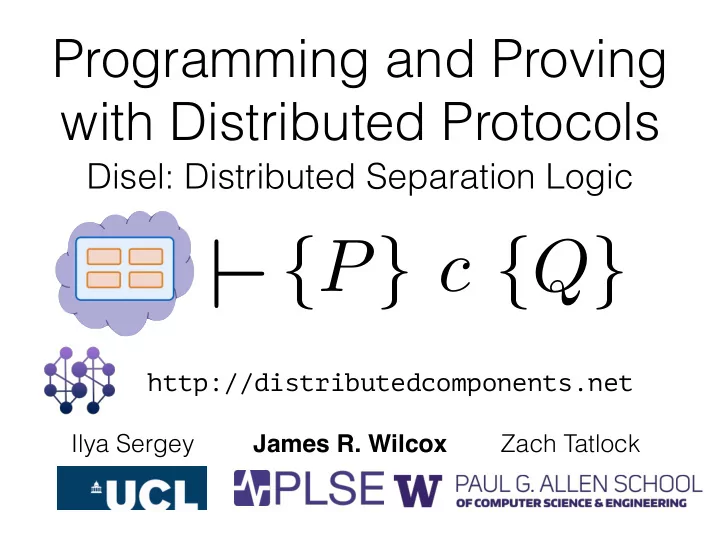

Programming and Proving with Distributed Protocols Disel: Distributed Separation Logic { P } c { Q } ` http://distributedcomponents.net Ilya Sergey James R. Wilcox Zach Tatlock
Distributed Systems
Distributed Infrastructure
Distributed Applications
Verified Distributed Systems
Verified Distributed Infrastructure Veri- Wow -Cert Iron
Verified Distributed Applications Veri- Wow -Cert Iron
Verified Distributed Applications Veri- Wow Challenging to verify apps in terms of infra. starting from scratch is unacceptable Indicates deeper problems with composition one node’s client is another’s server! -Cert Iron
Verified Distributed Applications Challenges Solutions Client reasoning Protocols Veri- Wow Invariants rule WithInv Separation rule/Hooks Frame ` { P } c { Q } -Cert Disel: Iron
Outline ` { P } c { Q } Protocols and running example Logical mechanisms programming with protocols invariants framing and hooks Implementation and future work
Cloud Compute 21 C S
Cloud Compute
Cloud Compute : Server while true: (from, n) <- recv Req send Resp(n, factors(n)) to from Traditional specification: messages from server have correct factors Proved by finding an invariant of the system
Cloud Compute: Server
Cloud Compute: Client
Cloud Compute: Client send Req(21) to server (_, ans) <- recv Resp assert ans == {3, 7} Start over with clients in system? In Disel: use protocol to describe client interface
Protocols
Protocols A protocol is an interface among nodes Enables compositional verification
Cloud Compute Protocol Messages: State: Transitions: Sends: precondition and effect Receives: effect
Cloud Compute Protocol Messages: Req(n) | Resp(n,s) outstanding: Set<Msg> State: Transitions: Req Resp Sends: Receives: Req Resp
Cloud Compute Req(21) C S Send Req(n) Precondition: none Effect: none
Cloud Compute Req(21) ( C ,21) { } C S Receive Req(n) add (from, n) to out Effect:
Cloud Compute { } C S Resp({3,7}) Send Resp(n,l) l == factors(n) Requires: (n,to) in out removes (n,to) from out Effect:
Cloud Compute { } C S Resp({3,7}) Recv Resp(n,l) Effect: none
Cloud Compute Protocol Messages: Req(n) | Resp(n,s) outstanding: Set<Msg> State: Transitions: Req Resp Sends: Receives: Req Resp
Outline ` { P } c { Q } Protocols and running example Logical mechanisms programming with protocols invariants framing and hooks Implementation and future work
Cloud Compute : Server while true: (from, n) <- recv Req send Resp(n, factors(n)) to from Precondition on send requires correct factors
Cloud Compute: Server t ∈ { Pre } ` { } m h send m to h send m to h ( ) sent t t t , while true: (from, n) <- recv Req send Resp(n, factors(n)) to from Precondition on send requires correct factors
Cloud Compute: Client send Req(21) to server (_, ans) <- recv Resp assert ans == {3, 7} recv doesn’t ensure correct factors
Cloud Compute: Client t ∈ ` { > } m { recvd ( ) } recv m t send Req(21) to server (_, ans) <- recv Resp assert ans == {3, 7} recv doesn’t ensure correct factors
Protocol Invariants ` { P } c { Q } I inductive 0 ` { P ∧ I } c { Q ∧ I } Protocol where every state satisfies I
Cloud Compute: Client t ∈ 0 ` { > } m { recvd ( ) } recv m t send Req(21) to server (_, ans) <- recv Resp assert ans == {3, 7} Now recv ensures correct factors
Cloud Compute: More Clients send Req(21) to server 1 send Req(35) to server 2 (_, ans 1 ) <- recv Resp (_, ans 2 ) <- recv Resp assert ans 1 ans 2 == {3, 5, 7} ∪ Same protocol enables verification
Frame rule ` { P } c { Q } R stable independent protocols ` { P R } c { Q R } ∗ ∗ Reuse invariants from component protocols
Frame rule: Hooks ` { P } c { Q } R stable ` { P R } c { Q R } ∗ ∗ Allows one protocol to restrict another
Outline ` { P } c { Q } Protocols and running example Logical mechanisms programming with protocols invariants framing and hooks Implementation and future work
Implementation Shallowly embedded in Coq with full power of functional programming Executable via extraction to OCaml via trusted shim to implement semantics Case study: two-phase commit exercises all features of the logic
Related and Future Work Concurrent separation logics Iris, FCSL, CAP, … Adding other effects e.g. mutable heap, threads, failure…
Composition: A way to make proofs harder “In 1997, the unfortunate reality is that engineers rarely specify and reason formally about the systems they build. It seems unlikely that reasoning about the composition of open-system specifications will be a practical concern within the next 15 years.”
Verified Distributed Applications Challenges Solutions Client reasoning Protocols Veri- Wow Invariants rule WithInv Separation rule/Hooks Frame ` { P } c { Q } -Cert Disel: Iron
Recommend
More recommend